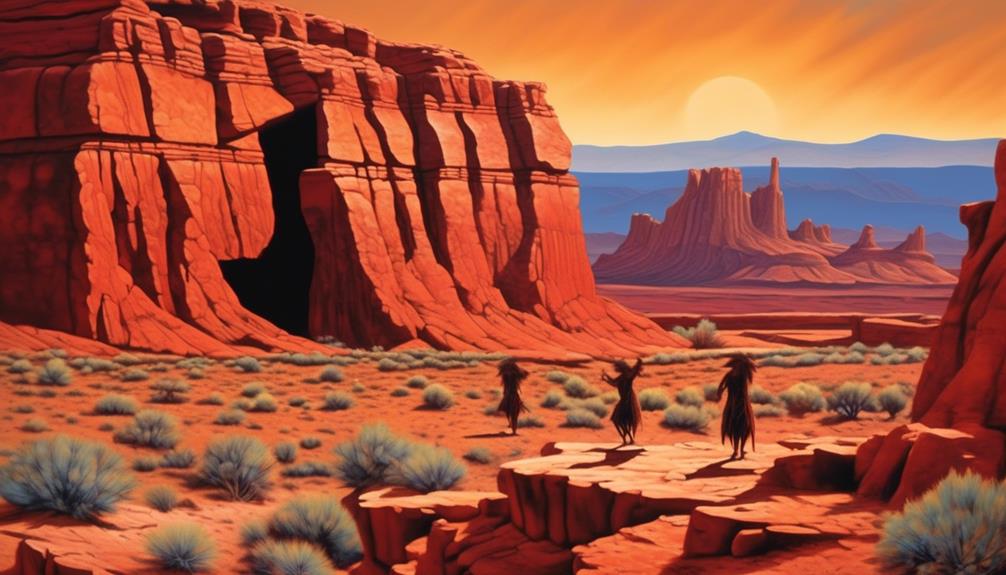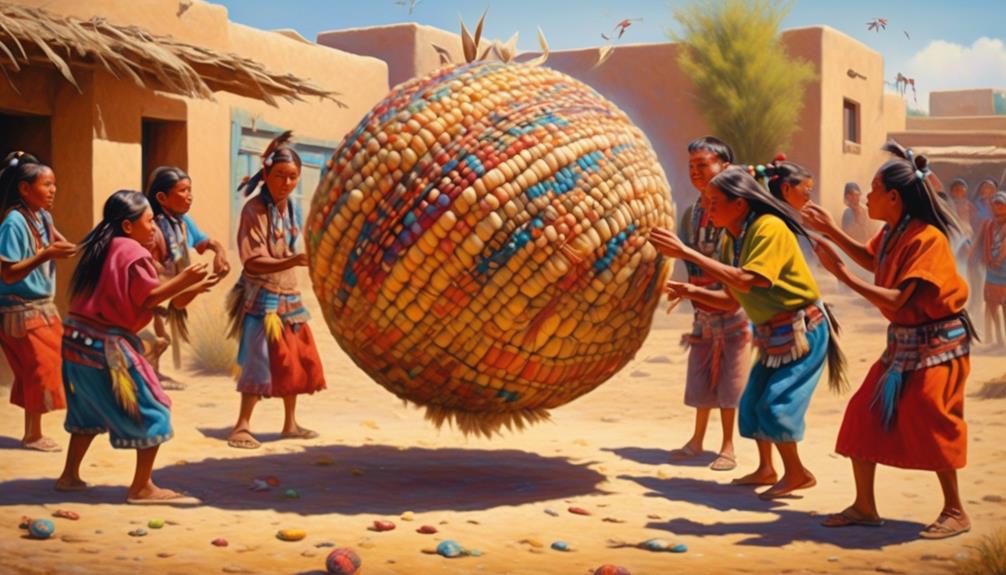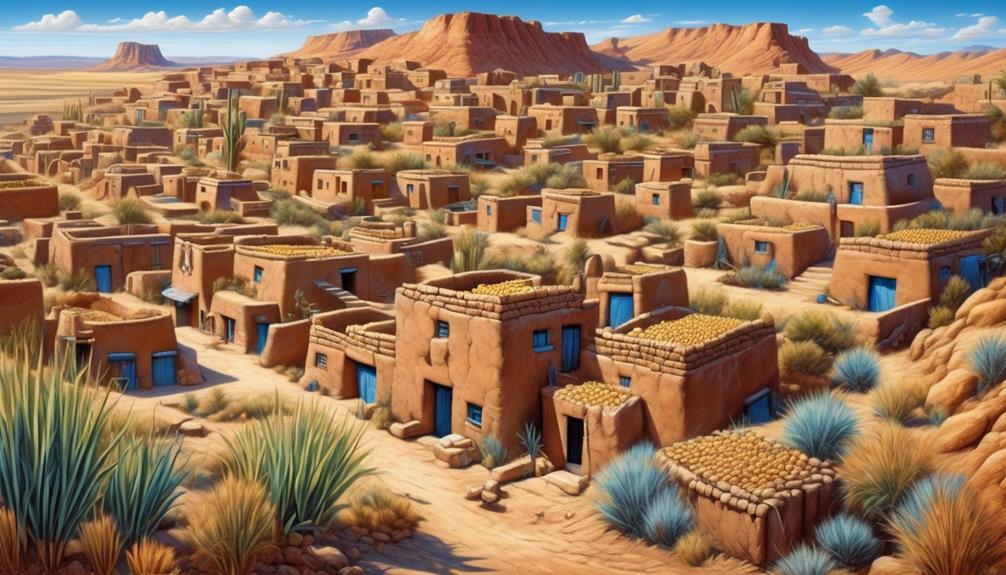How did the physical geography impact the unique development of the Hopi tribe?
The impact of geography on the Hopi tribe's history and culture is profound, with the arid desert landscape and isolation playing a significant role in their way of life.
The ways in which the tribe adapted and thrived in this challenging environment, and the spiritual connections they formed with the land, offer a fascinating insight into the intricate relationship between geography and human development.
As we explore the specific ways in which geography influenced the Hopi tribe, we will uncover a compelling story of resilience and adaptation that continues to shape their identity to this day.
Key Takeaways
- The arid desert landscape influenced the development of the Hopi Tribe through desert farming, settlement patterns, resilience, and a deep reverence for the land.
- The geographical boundaries and isolation of the Hopi Tribe helped preserve their distinct cultural identity and traditional way of life.
- The Hopi Tribe developed innovative agricultural practices such as terraced farming and irrigation techniques to sustain their community in the challenging desert environment.
- The Hopi Tribe's spiritual connections to the land shaped their cultural identity, belief in the land as a provider, and reciprocal relationship with nature.
The Arid Desert Landscape
The arid desert landscape has shaped the Hopi Tribe's development in profound ways, influencing their agricultural practices and settlement patterns. Desert farming has been central to the survival of the Hopi people for centuries. In the face of water scarcity, the tribe developed remarkable techniques to cultivate crops such as corn, beans, and squash. They constructed expansive networks of irrigation canals to efficiently utilize every drop of precious water. The Hopi also mastered the art of capturing and storing rainwater, essential for sustaining their agricultural endeavors in such a water-scarce environment.
Moreover, the challenging desert terrain led the Hopi Tribe to build their settlements atop three isolated mesas, providing natural defense and strategic advantages against potential invaders. This geographical feature hasn't only fostered a strong sense of community and unity but has also contributed to the preservation of their distinct cultural identity. Despite the hardships imposed by the arid desert landscape, the Hopi have thrived, demonstrating resilience, resourcefulness, and a deep reverence for the land.
Their profound connection to the earth serves as an inspiration for all who seek to serve others in harmony with nature.
Location and Isolation

Nestled within the remote and rugged terrain of northeastern Arizona, the Hopi Tribe's location has greatly contributed to their enduring isolation and distinct cultural identity. The geographical boundaries, including the vast desert landscapes and the natural protection offered by the mesa tops, have shielded the Hopi people from outside influences, fostering their unique traditions and way of life. This isolation has allowed the tribe to maintain their customs, language, and ceremonial practices, creating a strong sense of community and preserving their heritage.
| Challenges Posed by Location | Impact on Cultural Exchange |
|---|---|
| Limited access to resources | Hindered interaction with other tribes and cultures |
| Harsh environmental conditions | Preserved traditional way of life |
| Natural barriers | Maintained distinct cultural identity |
Despite the challenges posed by their location, the Hopi Tribe's isolation has also served as a protective barrier, safeguarding their cultural integrity. While geographical boundaries limited cultural exchange with other tribes, they also played a crucial role in preserving the rich traditions and beliefs that define the Hopi people.
Agricultural Practices
Surrounded by the arid landscapes of northeastern Arizona, our agricultural practices have been shaped by the harsh environmental conditions and the limited access to resources in our remote location. Despite these challenges, we've developed innovative techniques to sustain our agricultural endeavors and serve our community.
- Terraced Farming: Our ancestors ingeniously carved terraces into the hillsides, creating flat surfaces for planting crops. This method helped us maximize the use of scarce water resources and cultivate a variety of crops in an otherwise challenging terrain.
- Irrigation Techniques: We've mastered the art of channeling water from distant sources to our fields using an intricate system of ditches and canals. This efficient use of water has enabled us to nurture our crops and ensure a bountiful harvest, even in the midst of the desert.
- Adaptation to Climate: Our agricultural practices are closely attuned to the natural cycles of the land. We plant and harvest in harmony with the seasons, adapting to the extreme temperatures and limited rainfall in our region.
- Community Collaboration: Our agricultural practices aren't just about sustenance; they're a communal effort. Every member of our tribe plays a vital role in the cultivation and harvesting of our crops, fostering a spirit of unity and service to one another.
Spiritual Connections to the Land

Having cultivated our agricultural practices in harmony with the natural cycles of the land, our spiritual connections to the same terrain have deepened and shaped our cultural identity. Our cultural traditions are deeply intertwined with the land, as we believe that the earth is a living entity that sustains and nurtures us. Our ancestors have passed down invaluable ancestral knowledge about the environment, teaching us to respect and care for the land that provides for us. This connection goes beyond mere physical sustenance; it's a spiritual bond that influences our daily lives and rituals.
The environment isn't just a provider of resources for us; it's a sacred entity that we cherish and protect. Our spiritual connections to the land are reflected in our ceremonies, dances, and prayers, all of which celebrate and honor the earth's gifts. We believe that our relationship with the land is reciprocal, and we strive to maintain a harmonious balance with nature. This deep reverence for the environment has been a guiding force in our cultural development, shaping our values and traditions for generations.
Adaptation and Resilience
Drawing on our ancestral wisdom and the enduring spirit of our people, we've continuously adapted to the challenges posed by our environment, demonstrating resilience in the face of adversity. Our cultural traditions have been essential in shaping our survival strategies, allowing us to thrive in the harsh desert landscape. Through generations, we've honed our ability to adapt, ensuring the sustainability of our community.
Our resilience is evident in our ability to embrace change while preserving our heritage. Our survival strategies have evolved over time, blending traditional knowledge with innovative approaches to meet the demands of our environment.
Our adaptation and resilience are reflected in:
- Agricultural Innovation: Incorporating modern techniques while staying true to our traditional farming methods.
- Community Cooperation: Our collective effort to support one another during times of scarcity and abundance.
- Ceremonial Practices: Adapting rituals to align with environmental conditions, ensuring their continuity.
- Elders' Wisdom: Valuing the wisdom of our elders and integrating it with contemporary knowledge to navigate challenges.
Frequently Asked Questions
How Did the Hopi Tribe's Geographical Location Affect Their Interactions With Other Native American Tribes?
Intertribal relations were shaped by the Hopi tribe's geographical location. The landscape influenced interactions with other Native American tribes, fostering cultural exchange and resource management.
Social dynamics were impacted, and environmental adaptation and agricultural techniques were developed.
The geography facilitated trade and communication, shaping the tribe's identity and relationships with neighboring communities.
What Role Did the Geography Play in Shaping the Hopi Tribe's Traditional Architecture and Building Materials?
Geography profoundly influenced the traditional architecture of the Hopi Tribe. Our ancestral lands' natural resources, like sandstone and clay, shaped our choice of building materials.
The geographic features, such as mesas and cliffs, inspired our architectural style, like the iconic adobe dwellings.
Our building techniques, like using hand-molded adobe bricks, were adapted to suit the landscape.
These geographical influences are integral to understanding the Hopi Tribe's rich architectural heritage.
How Did the Unique Geography of the Hopi Tribe's Land Impact Their Trade and Economic Relationships With Neighboring Tribes and Settlements?
The unique geography of the Hopi tribe's land impacted their trade relations and economic impact with neighboring tribes and settlements. Geographical barriers like mesas and canyons influenced the routes for trade, shaping the tribe's economic relationships.
The landscape also facilitated cultural exchange, as neighboring tribes brought different resources and goods. This interaction influenced the development of the Hopi tribe's economy and trade networks, contributing to their overall development and prosperity.
What Were the Specific Challenges and Opportunities Presented by the Geography of the Hopi Tribe's Land for Their Hunting and Gathering Practices?
In our journey, we faced unique challenges and opportunities in hunting and gathering due to the geography of our land.
The rugged terrain made hunting a demanding task, but it also provided us with a diversity of game and resources.
On the other hand, the varied landscape offered abundant vegetation for gathering, allowing us to cultivate a rich and diverse diet.
How Has the Changing Climate and Environmental Conditions in the Region Affected the Hopi Tribe's Traditional Agricultural Practices Over Time?
The impact of climate on traditional farming has been significant for the Hopi Tribe. Geographical influences have shaped our agricultural practices, requiring adaptation to changing environmental conditions.
As a result, our tribe has had to adjust planting and harvesting methods to maintain sustainable food production. The changing climate has prompted us to innovate and develop resilient farming techniques, reflecting our commitment to serving others through responsible land stewardship.
Conclusion
In conclusion, the harsh desert landscape of the Hopi tribe shaped our way of life in profound ways. Our connection to the land runs deep, and our agricultural practices and spiritual beliefs reflect this bond.
Despite the challenges, we've adapted and thrived, proving that our resilience is as enduring as the desert itself. Just as the sun rises each day, so too do we rise to meet the challenges of our environment, rooted in the strength of our ancestors.









